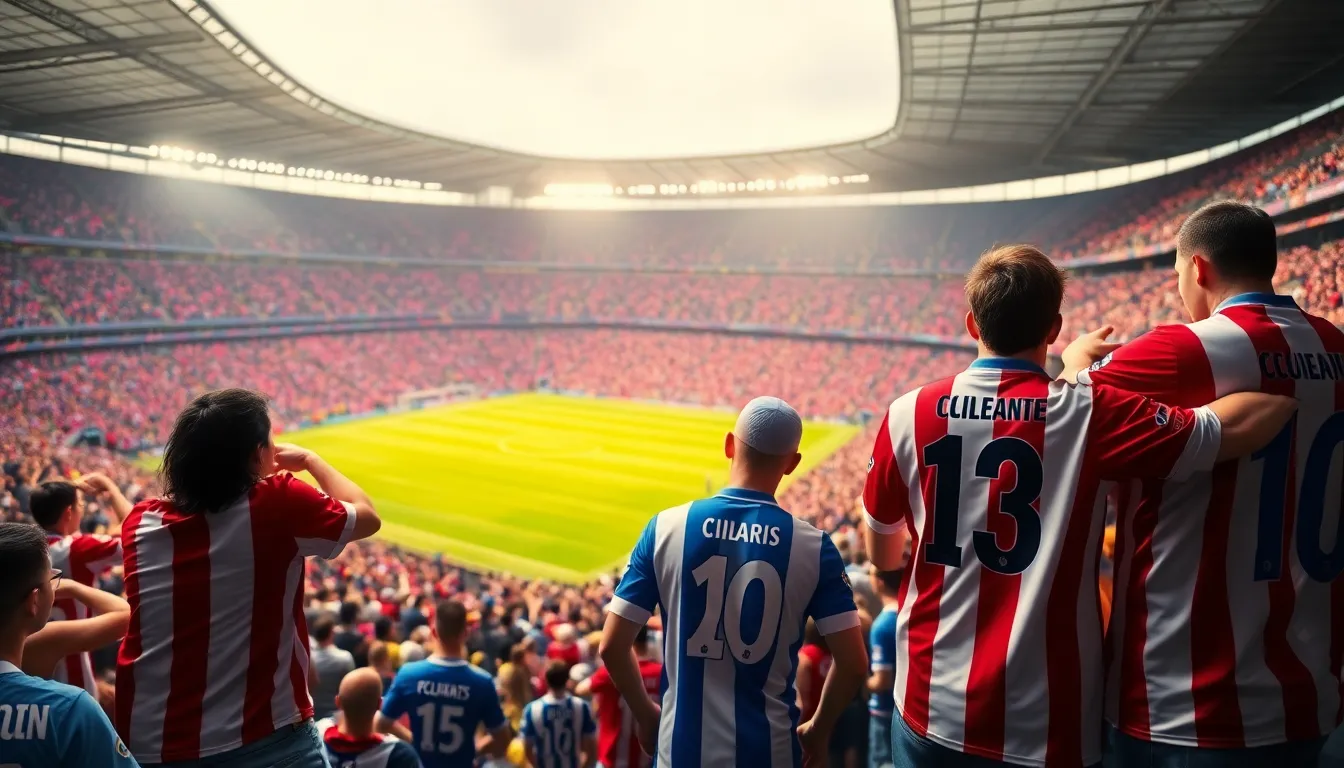The fierce rivalry between Real Sociedad and Athletic Bilbao is one of the most captivating in Spanish football. Known as the Basque Derby, this clash not only showcases the rich history of both clubs but also highlights their passionate fanbases. As each team gears up for battle, the lineups play a crucial role in determining the outcome of the match.
In this article, we’ll delve into the expected lineups for both teams, analyzing key players and tactical formations. Understanding these elements can provide valuable insights into how the game might unfold, making it essential for fans and analysts alike. Whether you’re a die-hard supporter or a casual observer, the anticipation surrounding this matchup is palpable, and the lineups will undoubtedly set the stage for an unforgettable encounter.
Table of Contents
ToggleOverview of Real Sociedad vs Athletic Bilbao Rivalry
The rivalry between Real Sociedad and Athletic Bilbao, known as the Basque Derby, stands as one of Spain’s most intense football rivalries. Both clubs, based in the Basque Country, boast rich histories and passionate fanbases. Established in 1909, this derby reflects deep-rooted regional pride and tradition.
The fierce competition began with Real Sociedad’s founding in 1909, followed by Athletic Bilbao’s establishment in 1898. Both teams share a strong commitment to developing local talent, which often intensifies their matches. The encounters regularly draw strong attendance and vibrant atmospheres, showcasing the fervent support from fans.
Statistical analysis reveals that Athletic Bilbao leads the overall head-to-head record in the derby, but Real Sociedad has demonstrated resilience in recent years, making this rivalry unpredictable. The matches often feature a blend of strategic gameplay and physical contests, enhancing the excitement for spectators.
Key players from both squads typically emerge during these derbies, often shaping the match’s outcome. Tactical formations also play a crucial role, reflecting the clubs’ distinct playing styles. The anticipation surrounding each clash heightens as both teams aim to assert dominance in the Basque region.
Key Factors Influencing Lineups

Key factors that influence lineups for the Real Sociedad versus Athletic Bilbao matches include current team form and player fitness levels. Assessing these elements provides deeper insights into potential strategies and selections for both teams.
Current Team Form
Current team form plays a crucial role in determining lineups. Both clubs often analyze recent performances in La Liga and cup competitions. For instance, if Real Sociedad showcases a strong attacking performance in their last few matches, they may opt for a more aggressive lineup. Conversely, if Athletic Bilbao struggles to find consistency, they might revert to more defensive tactics to stabilize their performance. Recent statistics, such as average goals scored and conceded, will further guide coaches in their selection decisions.
Player Fitness and Injuries
Player fitness and injuries significantly impact lineup choices. Injuries to key players can force adjustments in tactical formations. If a pivotal midfielder or forward is sidelined, coaches must adapt by either promoting reserve players or altering their formation to compensate for absences. Monitoring player recovery times is vital, as fitness levels can dictate whether a player features in the starting 11 or comes off the bench. Detailed injury reports and updates can provide clarity on who remains available for selection ahead of the matchday.
Analyzing Real Sociedad Lineup
Real Sociedad’s lineup plays a crucial role in their approach to the Basque Derby against Athletic Bilbao. The selection of key players and the chosen tactical setup will significantly impact the match’s outcome.
Key Players to Watch
- Martin Zubimendi: The central midfielder excels at dictating the tempo and linking defense with attack. His ability to regain possession can disrupt Athletic’s rhythm.
- Mikel Oyarzabal: As a dynamic winger, he poses a constant threat with his pace and dribbling skills. Oyarzabal’s goal-scoring capability makes him pivotal in breaking down defensive setups.
- Alexander Isak: The forward’s clinical finishing and positioning make him a key player in the attacking phase. His presence in the box often creates goal-scoring opportunities.
- David Silva: The veteran playmaker’s experience adds creativity and vision. Silva’s ability to read the game helps in unlocking tight defenses.
- Aritz Elustondo: The defender provides stability at the back. His aerial prowess and tackling skills are essential for thwarting Athletic’s aerial threats.
Tactical Setup
Real Sociedad typically employs a 4-3-3 formation, emphasizing ball control and quick transitions.
- Defensive Structure: The back four remains compact, with full-backs supporting the attack while ensuring defensive integrity.
- Midfield Dynamics: The three midfielders maintain fluid movement, enabling both defensive cover and offensive support. They interchange positions frequently to create passing lanes.
- Attacking Strategy: The front three exploits width, stretching the opposition. Wingers cut inside to create space for overlapping full-backs, enhancing offensive options.
- Pressing High: Real Sociedad often initiates high pressing to regain possession quickly, aiming to capitalize on opponent mistakes in their defensive third.
This strategic framework positions Real Sociedad favorably as they prepare for the rivalry against Athletic Bilbao.
Analyzing Athletic Bilbao Lineup
Athletic Bilbao’s lineup features a mix of experienced players and emerging talents. Key components of their strategy revolve around physicality and discipline, making their approach distinct in the Basque Derby.
Key Players to Watch
- Iñaki Williams: Known for his explosive speed and dribbling skills, Williams often serves as a vital attacking threat, capable of creating scoring opportunities and stretching defenses.
- Inigo Martinez: A strong presence in defense, Martinez excels in aerial duels and positioning. His ability to read the game helps maintain a solid backline.
- Unai Simon: The goalkeeper commands the area well and possesses reflexes crucial for facing high-pressure situations. Simon’s saves can significantly influence the match’s outcome.
- Muniain: As the team’s captain, Muniain provides creativity and leadership on the pitch. His playmaking abilities contribute to the attacking flow and set-piece execution.
- Oihan Sancet: An emerging talent, Sancet is known for his technical skills and vision. His contributions in midfield can determine the pace and rhythm of the game.
Tactical Setup
Athletic Bilbao typically adopts a 4-2-3-1 formation, emphasizing defensive stability and quick counterattacks. The double pivot in midfield allows for greater control and covers defensive gaps.
- Defensive Solidity: The back four remains compact, with full-backs supporting the attack but prioritizing their defensive duties. This duality ensures a tight formation that adjusts quickly to transitions.
- Midfield Dynamics: Central midfielders play a critical role in linking defense with attack, transitioning between phases with precise passing. Their positional awareness can exploit gaps in opponents’ defenses.
- Attacking Strategies: Wingers often stretch the play wide, creating spaces for central players to exploit. Quick, direct attacking transitions capitalize on any defensive hesitations from the opposition.
- Pressing and Recovery: Athletic Bilbao implements an aggressive pressing style when out of possession, aimed at regaining the ball quickly. This intensity can disrupt opponents’ buildup play, enhancing their chance of recovery.
Historical Lineup Trends
Real Sociedad and Athletic Bilbao exhibit distinct historical lineup trends influenced by their respective strategies and player development philosophies. Both teams emphasize local talent, fostering players primarily from the Basque region.
Real Sociedad’s lineups often feature a core of players who consistently perform at high levels, such as Mikel Oyarzabal and Martin Zubimendi. These players’ contributions reflect the team’s commitment to maintaining a competitive edge in La Liga. Historically, Real Sociedad showcases adaptability in tactics, frequently shifting between formations like 4-3-3 and 4-2-3-1, depending on the opponent’s strengths.
Athletic Bilbao’s lineups reveal a tendency toward experienced players alongside promising young talents. Players like Iñaki Williams and Iker Muniain not only bring speed and creativity but also experience that enhances team cohesion. The club’s lineup strategy incorporates a robust emphasis on defensive organization, primarily through a 4-2-3-1 formation, ensuring stability while leveraging counterattacking opportunities.
Head-to-head meetings between these two teams highlight historical trends. They often draw upon a mix of physicality and tactical intelligence, making lineup decisions critical. Athletic Bilbao typically relies on pressing and ball recovery methods, while Real Sociedad focuses on possession-based tactics that create scoring chances.
Tracking these historical lineup trends provides insights into how both clubs adapt to evolving football dynamics, ultimately shaping each derby’s outcome.
The upcoming clash between Real Sociedad and Athletic Bilbao promises to be another thrilling chapter in the storied Basque Derby. With both teams showcasing a blend of experienced players and emerging talents their lineups will be crucial in determining the match’s outcome. Real Sociedad’s focus on quick transitions and ball control contrasts sharply with Athletic Bilbao’s emphasis on defensive stability and counterattacks.
As the rivalry continues to evolve both teams will look to their key players to make an impact on the pitch. Fans can expect a fiercely contested match that reflects the deep-rooted pride and tradition of Basque football. The anticipation surrounding the lineups adds an extra layer of excitement making this derby a must-watch event for football enthusiasts.





